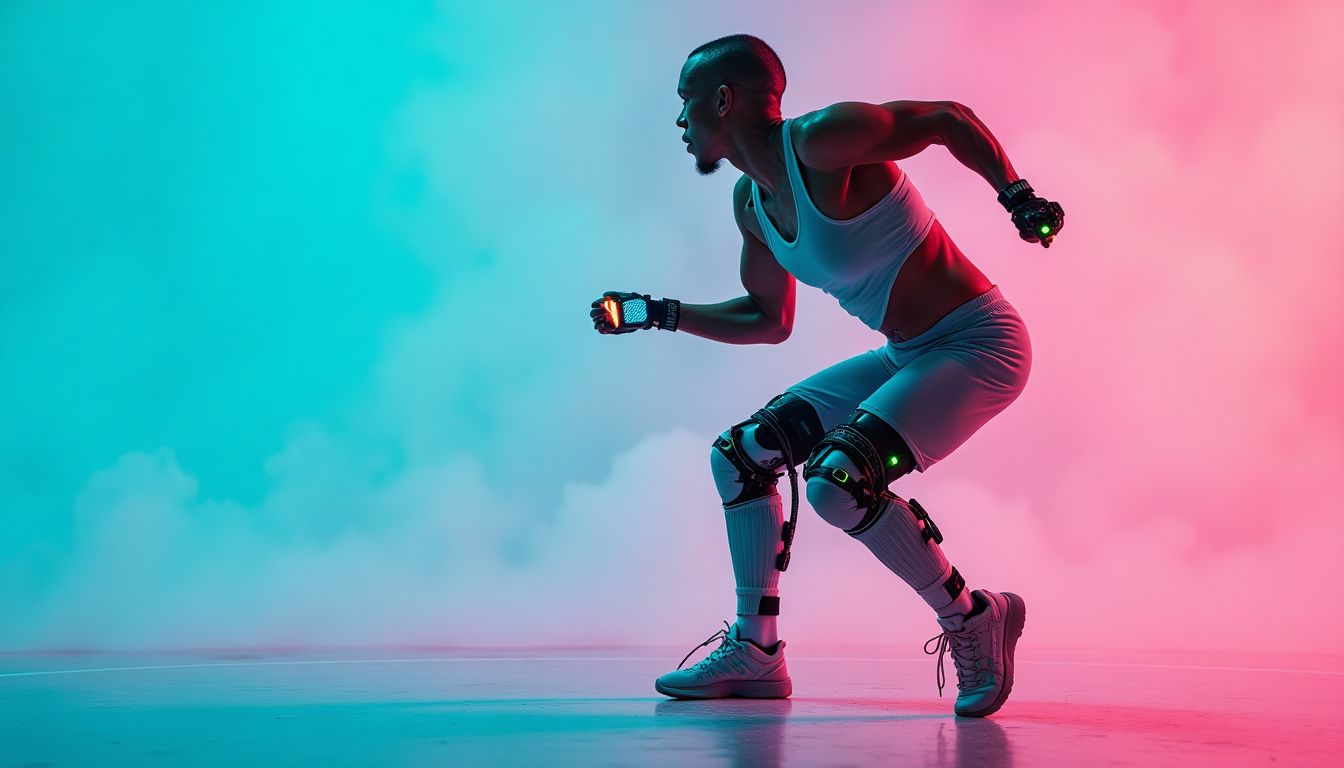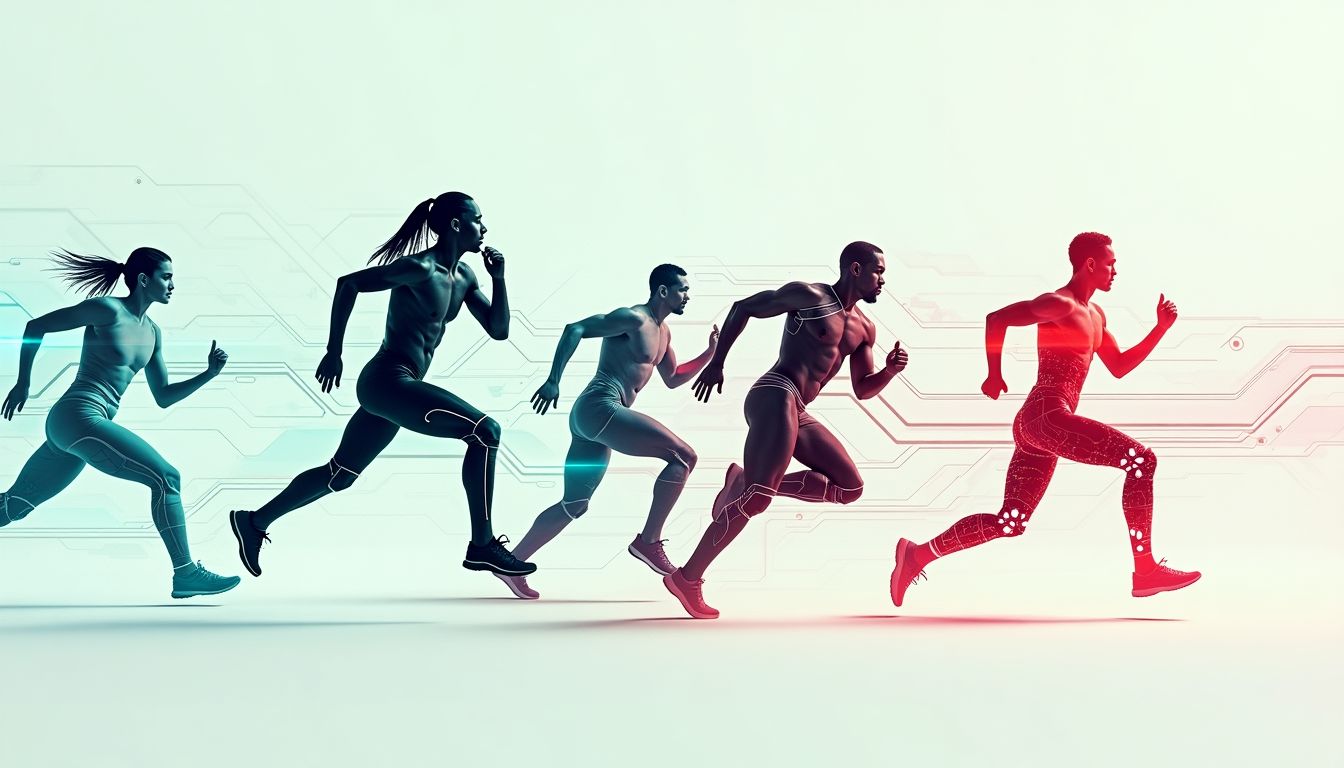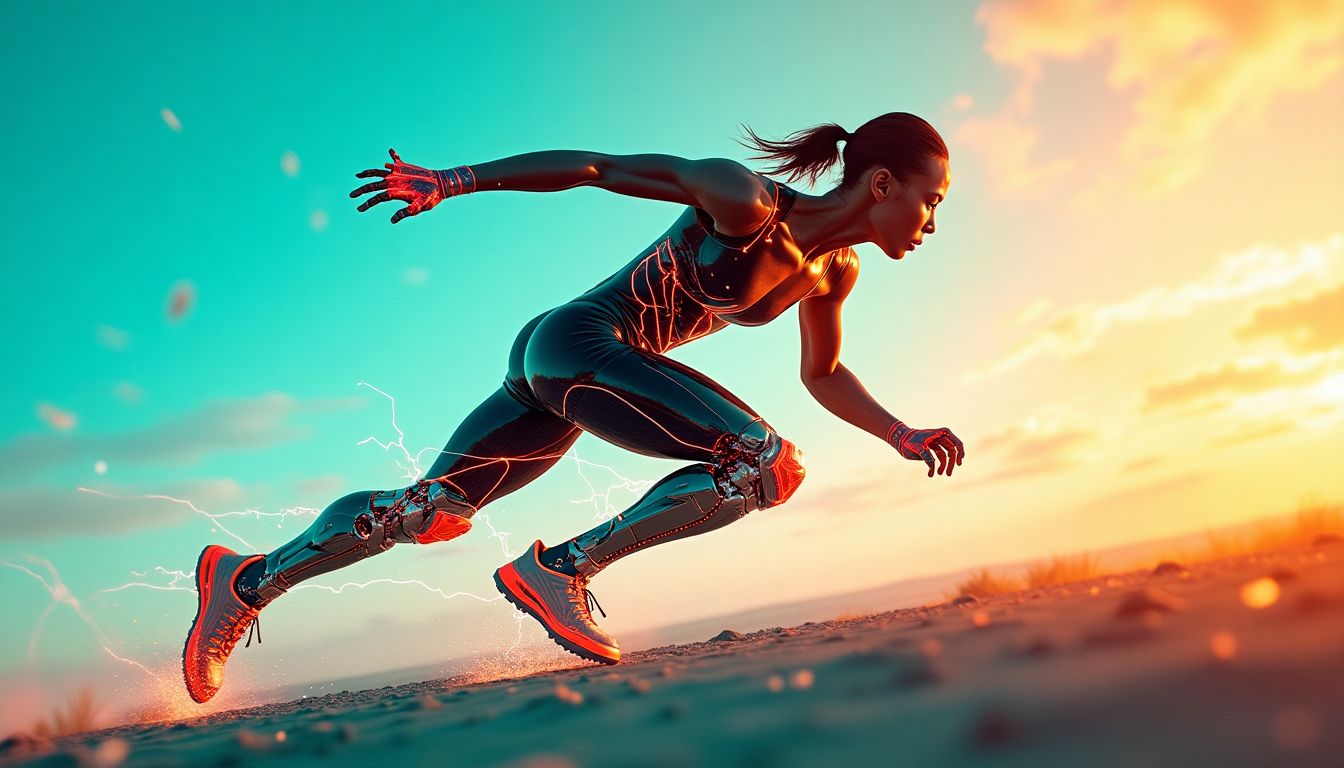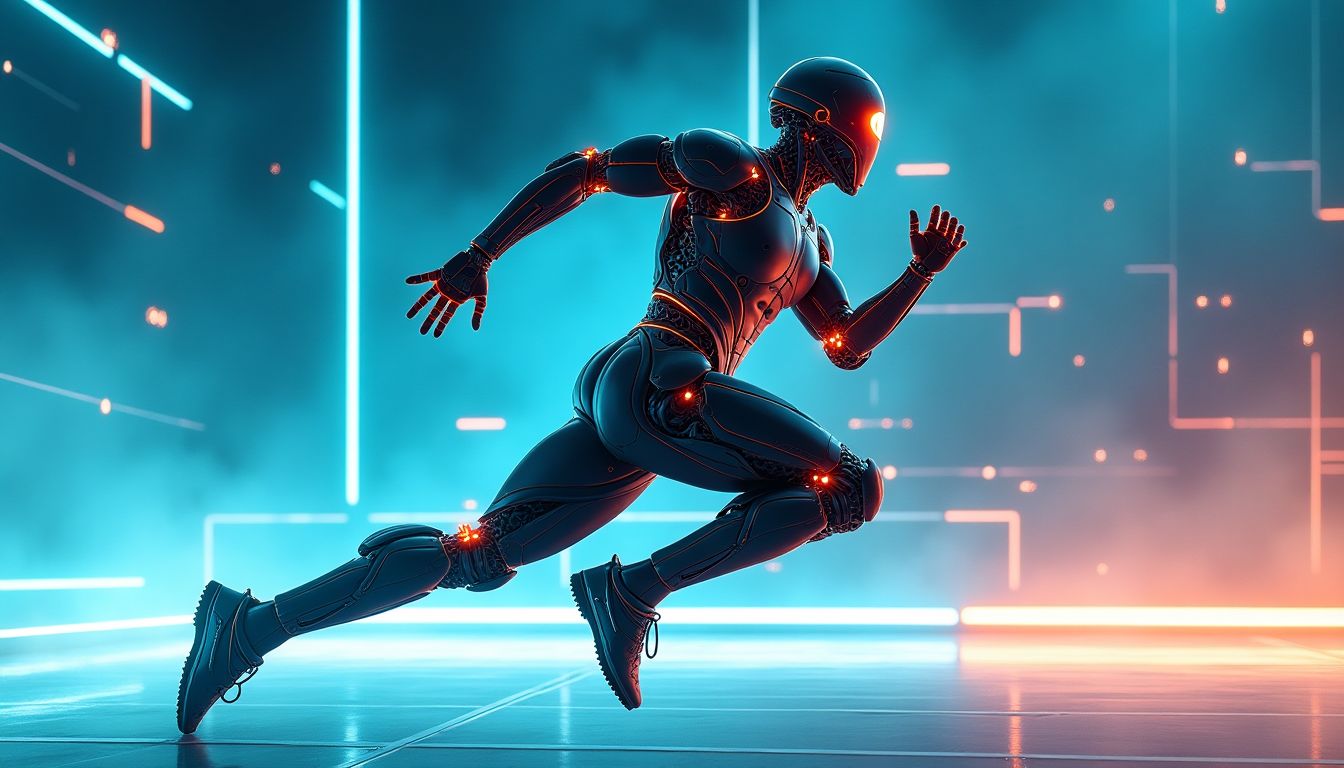Introduction: The Future of Athletic Competition
The only limit to our realization of tomorrow will be our doubts of today. – Franklin D. Roosevelt This stirring quote presses us to consider the limitless potential of human achievement, akin to the burgeoning world of cyborg athletes, where the lines between muscle and machine blur spectacularly. Much like FDR envisioned a society unshackled by doubts, today's athletes and technologists seek to break free from the constraints of biology, opening doors to athletic prowess previously thought impossible. With every innovation in cybernetics, the future beckons with promises of superhuman capabilities.
Are we ready to witness a new era in sports where traditional human ability takes a backseat to the dazzling might of technological enhancements?
Cyborg athletes – this fascinating concept transforms our understanding of sports, blending humanity and technology into a thrilling spectacle. How does a simple leg prosthetic lead to record-breaking performance? Or, how might an exoskeleton redefine competitive advantage on the running track? These questions aren’t just theoretical; they present a reality we’re racing toward faster than Usain Bolt can depart the starting blocks. As experts like MIT’s renowned bioengineer Hugh Herr, scientist and technologist Nicolas Nicolaou, and AI visionary Sam Altman discuss, we are standing on the precipice of a vibrant, new epoch in sports where machines enhance our natural abilities.
1. The Evolution of Sports: From Muscle to Machinery
The historical context of sports reveals how technology has continually shaped athletic endeavors.
1.1 Emergence of Technological Enhancements
From prehistoric athletes throwing stones to the modern Olympians donning high-tech gear, technology has been an irreplaceable companion to sports. The introduction of running spikes in the 1920s made athletes soar, literally. Those spikes, designed to dig into the track, gave runners an edge, resulting in some of the fastest times recorded. And what about the high-tech swimsuits that sent shockwaves through competitive swimming? With their sleek materials and streamlined designs, they transformed casually floating in the water into a high-speed race. We’ve come a long way from wooden tennis rackets and leather footballs!
1.2 Milestones of Evolution
When we look back, there are key milestones that spotlight the journey toward cybernetic enhancements in sports. For example, in 1960, the introduction of the first functional prosthetic leg changed the game for athletes with disabilities. Fast forward to 2016 when the Paralympic Games showcased competitors using advanced prosthetics, inspiring a surge of innovation in the field. As technologies continue to evolve, from brain-computer interfaces to sophisticated exoskeletons, we inch closer to realizing what may someday be the norm in athletic competition. With every leap and bound, we redefine what it means to be an athlete!
2. The Anatomy of a Cyborg Athlete
What defines a cyborg athlete? There's a lot more than meets the eye (or the bionic knee)! In this section, we’ll delve into the fascinating anatomy of someone who has embraced enhancements and what it truly means to be a cyborg in sports.
2.1 Types of Enhancements
Cyborg athletes utilize a variety of cybernetic enhancements that push the boundaries of human capability. Let’s break it down:
- Exoskeletons: These are like superhero suits that athletes wear. They can help support movements, boost strength, and reduce fatigue. Imagine being Iron Man but with a little less flying and a little more sprinting.
- Neural Interfaces: Ever wondered how computers might connect to our minds? Neural interfaces do just that! They allow direct communication between the athlete’s brain and the device, improving motor functions and reaction times.
- Biofeedback Mechanisms: Think of these as your personal coach inside your body, collecting data on how you’re performing. They can track heart rate, temperature, and muscle activity, providing real-time information to enhance training. It’s like having a Fitbit on steroids—kidding! Not really on steroids, just awesomely advanced technology!
2.2 Case Studies of Cyborg Athletes
Let’s talk about some trailblazers in the world of cyber-enhancements:
- Oscar Pistorius: A South African sprinter, Pistorius made headlines with his carbon-fiber blades. Though controversial, his story pushed the boundaries of what we consider natural ability in sports. Learn more about him on his Wikipedia page.
- David Mzee: This pioneering athlete became the first person with a complete spinal cord injury to run with a powered exoskeleton. His journey shows that with technology, even the sky isn’t the limit. You can find more about him here.
3. Ethical Implications and the Spirit of Competition
The intersection of technology and ethics in sports is like walking a tightrope. One misstep, and the balance shifts! The rise of cyborg athletes raises complex dilemmas that demand our attention.
3.1 The Doping Debate
When we hear the word "doping," we think of banned substances that give athletes an unfair edge. Now, imagine combining this with cyborg enhancements. Are they just improved versions of doping? This debate is heating up, making it essential to chart the differences and draw parallels. Traditional doping is like sneaking candy into the supermarket, while cybernetic enhancements could be like having a new, shiny shopping cart that moves faster. What's fair and what's foul?
3.2 The Changing Definition of Ability
As cybernetic enhancements redefine what we consider ‘natural’ athletic ability, we may need to rethink our views. If an athlete’s prosthetic limb helps them break sprinting records, do we cheer or question their authenticity? It’s like watching a magic show; we’re awestruck, but is it really magic or just clever tech? Additionally, this exploration will challenge societal perceptions of performance, raising questions about who gets to claim the title of an athlete. Can a human still be ‘human’ with a machine attached to them? The age-old debate about what it means to be human is now back in the arena!
4. Regulatory Frameworks and Governing Bodies
As technology continues to advance and shapeshift through various stages of innovation, the sporting community finds itself grappling with a pressing need for regulations. The conversation surrounding cyborg athletes creates complexities that merit systematic and thoughtful discourse. Governing bodies in sports are tasked with maintaining fair play, ensuring the integrity of competitions, and catering to the diversity of human potential.
4.1 Role of Organizations
Organizations such as the International Olympic Committee (IOC) and FIFA are beginning to address the rise of cyborg athletes. Their roles encompass several vital guidelines aimed at ensuring fairness in competition:
- Developing Clear Standards: Establishing what constitutes a cyborg enhancement and which technologies are allowed.
- Testing Protocols: Creating rigorous assessments to ensure that enhancements do not confer undue advantages.
- Addressing Ethics: Engaging in meaningful conversations about the definition of performance and the implications of enhancements.
4.2 Future Regulations
The future of regulations may require a comprehensive approach. Consider these possible developments:
- Global Collaboration: International cooperation among governing bodies to maintain consistency in regulations.
- Adaptive Guidelines: Regulations that evolve based on technological advancements and emerging patterns in athlete performance.
- Education and Awareness: Raising public awareness about the implications of enhancement technologies in sports.
This ongoing evolution demands diligent observation, as the balance between innovation and equality remains precarious. By carefully crafting regulations, organizations safeguard the spirit of competition while also embracing advancements.
5. The Technological and Cultural Impact on Society
Beyond the boundary lines of athletic fields, the rise of cyborg athletes carries significant implications for culture and society. As we witness this new wave of sporting evolution, it's important to explore how these advancements transcend mere performance upgrades, impacting broader societal norms and values.
5.1 Cultural Representation of Cyborgs
How people perceive cyborg athletes is significantly influenced by media portrayals. Movies, TV shows, and literature shape public attitudes toward technology and athletics. Here are some ways media representation matters:
- Normalizing Cyborgs: Positive portrayals of cyborg characters can create acceptance and inspire innovation.
- Creating Stereotypes: Conversely, negative representations may fuel fears about loss of authenticity in sports.
- Encouraging Dialogue: Media narratives can ignite discussions around ethics, equity, and our understanding of human capability.
5.2 Societal Shifts
The impact of cyborg athletes extends to significant societal shifts:
- Advancements in Health Technology: Innovations developed for athletes can enhance rehabilitation options for individuals with disabilities.
- Accessibility: Enhanced technologies can democratize access to sports and exercise for everyone, not just elite athletes.
- Changing Attitudes: Societal views toward disabilities may evolve, fostering a culture of inclusion and acceptance of diverse abilities.
In sum, the connection between sports, technology, and society is not just a future concern; it’s a present inevitability. As cyborg athletes emerge on the scene, their influence will echo throughout our lives, potentially redefining not only what it means to compete, but also what it means to be human.
6. AI Solutions: How Would AI Tackle This Issue?
As we venture into an era influenced by cybernetic enhancements, Artificial Intelligence (AI) emerges as a game-changer, poised to revolutionize how we approach sports and athleticism. With its ability to analyze mountains of data, predict trends, and customize training, AI serves as a catalyst for innovation in cyborg athletics, ensuring the integration of technology is both ethical and effective.
6.1 Understanding Patterns and Data
AI algorithms can sift through vast amounts of data generated by athletes, differentiating between those using enhancements and those relying on traditional training methods. By identifying effective training patterns and performance metrics, AI can inform coaches and athletes about what works best. Think of it like having a digital teammate who never gets tired of crunching numbers, making recommendations based on the latest insights.
6.2 Personalized Training Programs
Imagine a world where every athlete has a personalized training regimen designed specifically for them! AI can analyze individual performance data, taking into account factors like the type of enhancements used, past performance traits, and even mental health. By integrating this information, AI can craft tailored training programs that maximize each athlete's potential while minimizing injury risk. Companies like Athos already use wearable technology to track muscle performance. It won't be long before AI makes this process even more adept.
6.3 Regulation and Compliance Tracking
As the landscape of cyborg athletics evolves, maintaining integrity is essential. AI can offer a solution by monitoring compliance with regulations established by governing bodies. By leveraging advanced algorithms, organizations can track the use of enhancements, ensuring fair play and transparency. Think of AI as the ultimate referee—watching, measuring, and keeping athletes accountable for their choices.
6.4 Predicting Performance Outcomes
Perhaps one of the most exciting aspects of AI in this context is its predictive capabilities. Using machine learning, AI can forecast athletic performance based on various enhancement scenarios. Imagine coaches having the ability to simulate outcomes before the big game, allowing them to strategize in real-time! This predictive modeling can inform training adjustments and competition strategies. Innovations in AI from companies like IBM Watson hint at just how powerful these tools could become.
Actions Schedule/Roadmap (Day 1 to Year 2)
Day 1: Assemble a multidisciplinary team consisting of sports scientists, data analysts, bioethicists, and AI developers. Task this team with assessing the current landscape of cybernetic athletics and identifying goals for AI integration.
Day 3: Begin the process of gathering and organizing data on existing cybernetic technologies and their impact on performance. Collaborate with universities like MIT and Stanford University for access to their extensive research networks.
Week 1: Develop partnerships with tech companies specializing in AI and wearables. Establish connections with organizations like Nike or Adidas, who already have an interest in cutting-edge sports technology.
Month 1: Launch pilot programs integrating AI into athlete training. Utilize platforms like TrainingPeaks to analyze performance data effectively during initial runs.
Month 3: Organize a symposium with thought leaders in sports ethics and AI, creating an expert consensus on the direction and future of cyborg athletics.
Month 6: Implement AI systems for monitoring compliance with established guidelines and evaluate their effectiveness in real-time applications.
Year 1: Conduct a comprehensive review of pilot program outcomes and make adjustments based on findings. Begin drafting ethics protocols for cybernetic enhancements.
Year 1.5: Release a public report detailing findings, best practices, and recommendations for the ethical use of AI and cybernetic enhancements in sports, generating an ongoing dialogue with stakeholders.
Year 2: Establish a formal governing body tasked with overseeing AI's impact on sports, ensuring accountability and transparency. This governing body should also serve as a platform for discussions regarding enhancements and evolving technologies.
Conclusion: The Path Forward
The journey into the realm of cyborg athletes is exciting and daunting, teetering on the edge of scientific and ethical boundaries. In this new age, harnessing AI strategically presents an opportunity not just to redefine sport, but to reimagine what it means to compete. By carefully integrating technology into athletic practice, ensuring compliance with rigorous ethical standards, and advancing personalized training methods, we can create an inclusive and equitable sports environment that values both human spirit and innovation. But how do we ensure we stride forward without losing sight of our humanity? What responsibility do we hold when blending the boundaries of biology and technology? These are questions worth pondering as we embark on a future where the extraordinary potential of cyborg athletes awaits—an illustrated canvas of possible futures where dreams of enhanced athleticism come to life.
FAQ
- What are cyborg athletes?
Cyborg athletes are people who use technology to improve their physical abilities. This includes things like advanced prosthetics that help them run faster or exoskeletons that provide extra strength. Technology is changing the way we look at athletes and how they compete. For more on prosthetics, check out the American Psychological Association's insights on rehab and technology. - Are cybernetic enhancements allowed in sports?
The rules vary by sport. Some organizations allow certain types of enhancements, like comfortable prosthetics for athletes with disabilities, while others may ban them. The sporting world is still figuring out how to regulate technology in athletics. For example, the International Olympic Committee is working on guidelines for this. - What are the ethical concerns surrounding cyborg athletes?
Several ethical issues arise with cyborg athletes. Here are some key points:- Fairness: Is it fair for athletes to have different levels of access to technology?
- Pressure: Will athletes feel they must enhance themselves to keep up with their peers?
- Authenticity: How do we define a “natural” athlete?
These concerns create tough conversations about equity and integrity in sports. A detailed discussion can be found in the National Institutes of Health (NIH) article on ethics in sport enhancement.
- How might AI change the nature of sports?
AI can help in several exciting ways:- Personalized Training: AI can analyze an athlete's performance and create customized training programs just for them.
- Compliance Monitoring: AI tools can keep track of athletes using enhancements, ensuring everyone follows the rules and regulations.
- Performance Analysis: AI can predict how well an athlete might do based on their training and enhancements.
Imagine AI becoming a coach for every athlete, making them better, faster, and more prepared. If you're curious about how AI is changing sports today, you can read more at Forbes.
- What types of enhancements are available for athletes?
Athletes can access various technologies, some of which include:- Exoskeletons: Wearable devices that can help with strength and mobility.
- Neural Interfaces: Technology that connects directly with the nervous system to help control movements.
- Biofeedback Mechanisms: Devices that monitor physiological responses to improve performance.
Each enhancement is designed with the goal of pushing boundaries and achieving new heights in sports. You can explore cutting-edge advancements in wearable technology through Wired's wearable tech insights.
Wait! There's more...check out our gripping short story that continues the journey: The Flickering Spark
Disclaimer: This article may contain affiliate links. If you click on these links and make a purchase, we may receive a commission at no additional cost to you. Our recommendations and reviews are always independent and objective, aiming to provide you with the best information and resources.
Get Exclusive Stories, Photos, Art & Offers - Subscribe Today!





























Post Comment
You must be logged in to post a comment.